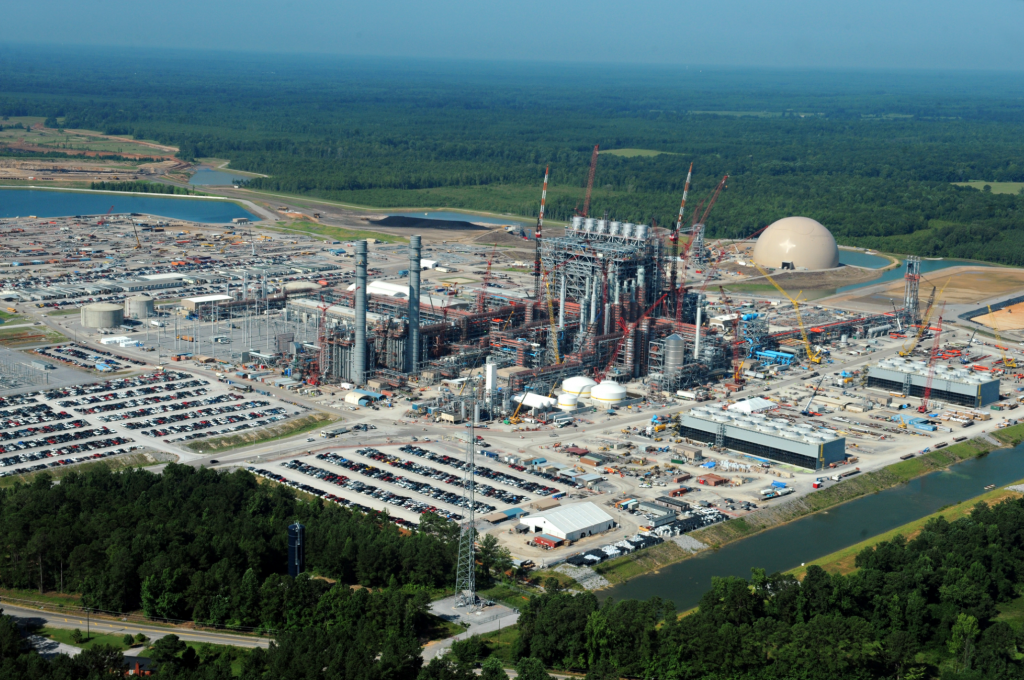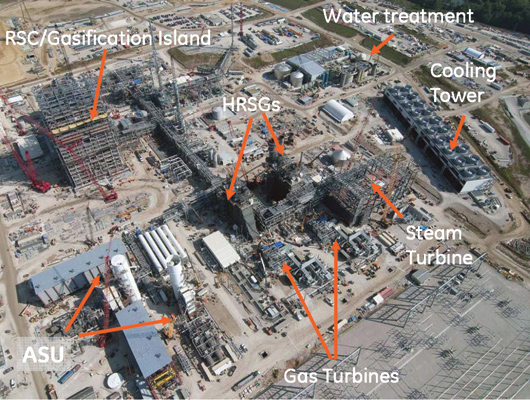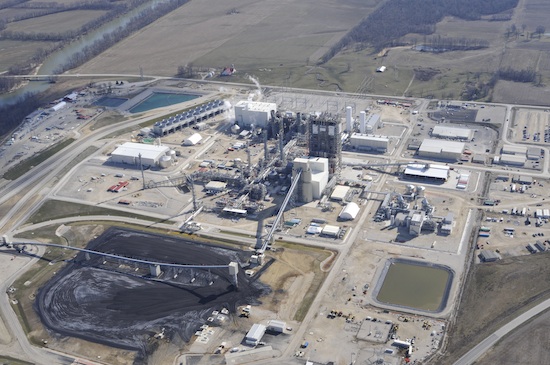Energy Secretary Ernest Moniz in November last year visited the new Kemper power plant in Mississippi. After touring the plant he said: “I consider seeing this plant a look at the future.” It was probably meant that Kemper will be the big bang for future coal fired power plants. However, massive cost overruns and project delays have added arguments to the critics saying that this is not a viable future.

582 MW IGCC power plant under construction. Kemper, Mississippi. Owner: Mississippi Power, subsidiary of Southern Company.
Coal is worldwide the dominant fuel source for electric power generation. 2012 coal fired power plants produced 41 % of all electric energy. In the United States corresponding number was 37 %. From 2000 to 2011 global coal consumption rose 54 %, primarily driven by China and India.
Coal is abundant and has a low cost. However, it comes with many environmental issues such as air quality and carbon dioxide (CO2), the main greenhouse gas. In 2011 almost half of the global fossil fuel generated CO2, including transportation, came from burning coal, mostly for electric power production.
The air quality challenges include sulphur dioxide (SO2), nitrogen oxides (NOx), mercury and particulate matters. For raw exhaust gases the values are high. Treating the exhaust gas in “scrubbers” the air quality related emissions can be substantially reduced and get in compliance with the air quality standards. Most modern coal fired power plants have invested in “scrubbers” and similar technologies. However, many old coal plants in the U.S. do not have exhaust gas cleaning, but they have been grandfathered for a long time. When the Environmental Protection Agency (EPA) in December 2011 tightened the Mercury Air Toxics Standards (MATS) at the same time shale gas had made natural gas so much more competitive, it was in most cases deemed uneconomical to invest in exhaust gas cleaning technologies. Instead those plants are retiring.
The CO2 issue remains. It is estimated that of all emitted CO2 2012 in the U.S. over 20 % comes from power plants. Addressing this issue Department of Energy (DOE) in the last three decades has invested $6.5 billion in advanced coal technologies, frequently referred to as “clean coal” technologies. There are different technologies, but Integrated Gasification Combined Cycle (IGCC) with Carbon Capturing and Sequestration (CCS) has become the leading choice.
To best way to capture CO2 is to capture it before the combustion. The IGCC concept is based on exactly that. Basically the concept is to produce syngas (primarily hydrogen, H2, and carbon monoxide, CO) from oxygen and coal or other carbon-containing feedstock in a gasifier. The CO2 is separated from the syngas, which is combusted in a gas turbine. The exhaust gas is supplemented by steam produced by the gasifier in a Heat Recovery Steam Generator (HRSG) and then used for a steam turbine. Conceptually it may sound straight-forward, but in reality it is a very sophisticated process and anything but a trivial engineering undertaking.

IGCC power plant.
RSC = Radiant Syngas Cooler. ASU = Auxiliary Steam Unit. HRSG = Heat recovery Steam Generator.
The CCS concept is to capture the CO2, compress and transport to a site suitable for sequestration, i e injection and storage in the ground. Originally the idea was to sequester in saline formations, depleted oil and natural gas wells and other geologically stable cavities. Several pilot projects have shown that it technically works. However, after serious efforts and high costs Europe, by many seen as the leader in research and development of CCS, has abandoned the plans for large scale CCS. Since 2007 Norway with support from the European Union have invested $1.2 billion in developing a large scale CCS at Mongstad. In fact it has been the world’s largest test for CCS. In September 2013 the Norway Government and Statoil have announced that they have cut off the support for the project. (Interestingly Statoil continues to sequester carbon from its offshore oil and gas exploration on or close to site at the Sleipner and Snövit fields. The 50 Euro per ton tax on offshore CO2 emissions makes it the best economical solution.) In May 2014 Vattenfall, as the “last man standing” of European power companies developing CCS for power plants, announced that they have stopped their R&D and large scale test for CCS. In the US for similar reasons AEP (American Electric Power) in early 2011 ended its technically successful pilot project at the Mountaineer Plant in West Virginia.
A more attractive alternative to sequester CO2 is to use the CO2 for enhanced oil recovery (EOR). Injecting CO2 in oil wells to enhance production was pioneered in West Texas 1972. The most significant project to date has been at the Weyburn oil fields near Midale, Saskatchewan, Canada. A first research project of injecting CO2 began 2000. It was followed by a ‘Final Phase project 2005 to 2011. Thanks to the EOR the Weyburn fields are expected to get a 20 – 25 years life extension and to produce 30 % more oil. Consequently, if CO2 from a power plant can be used for EOR it will have a value. The value is linked to the price of oil. At $90 per barrel of oil $40 per ton CO2 is economical.
Kemper power plant will be the first full scale power plant with in the world both IGCC and CCS. The CO2 will be transported 62 miles by a pipeline to Heidelberg oil fields in Texas, operated by Denbury Resources, a company focused on EOR. Consequently, ever since the groundbreaking in 2008 expectations have been high that Kemper would become the benchmark for future coal power plants, not only in the US but worldwide.
Mission is not yet completed. Technical, construction and project management challenges have delayed the project. The latest update is that it will go on line in May 2015. When it goes live it will represent major technical progresses. For example the IGCC process has been developed to operate of lignite, which is local low BTU coal. This particular process, Transport Integrated Gasification (TRIG) was developed by Southern Company, KBR (Kellogg, Brown & Root) and DOE.. About 65 % of the CO2 will be captured. The plant will have a closed loop water treatment system.
Nevertheless, the biggest challenge will be the cost. Originally the project was estimated to cost $ 2 billion. It is now forecasted to cost $ 5.53 billion. It is about $9500 per kW. It is higher than any other type of generation, including new nuclear. As a comparison a natural gas fired combined cycle gas turbine (CCGT) is at $1200 per kW.
Arguments have been made that Kemper is a first of its kind and that costs will come down. It will, but will it come down enough? In terms of IGCC Kemper is not a first. Many others have been built both in the United States and Europe. Indications are rather that costs have gone up than down. A similar IGCC plant, but without the CCS, has recently been built in Edwardsport, Indiana. Edwardsport, which is a 618 MW plant, commenced operations in July 2013. Originally it was calculated to be a $1.985 B project. The final bill came in at $3.554, which is about $5650 per kW. GE and Bechtel have been the main contractors for both Edwardsport and Kemper. The European and Japanese IGCC projects seem to have been built at a lower cost, but still the costs are high. European IGCC plants (without CCS) like Buggenum in the Netherlands, which uses coal and 30 % biomass as a supplemental feedstock, seems to perform quite well.
The core problem is the electric efficiency. Presently IGCC plants seem to be in the 40 % efficiency range, which is about the same as the super critical (SC) and ultra-super critical (USC) plants. If CCS is added, about 25 % is lost for the separation, compression and transportation of the CO2. It brings the net electric efficiency down to the level of existing coal power plants and much lower than the SC and USC plants. Southern Company estimates that annually they will receive about $50 million from sales of CO2 and other by-products. It may offset a good portion but not all of the parasitic losses (for the CCS) of electricity.
Even in future best case scenarios of IGCC process reaching 46 – 48 % efficiency, it will put the net efficiency of an IGCC power plant with CCS on par with the SC and USC plants. Unless a very high tax for carbon or a very high value of CO2 for EOR, it looks uphill for IGCC to compete with SC and USC. Even more uphill it is to compete with the 60 % efficient natural gas fired CCGT, which may also emit about the same or less CO2 than an IGCC with CCS!
Right or wrong, Kemper is a big bet by DOE, the Mississippi rate payers and Southern Company shareholders. DOE is contributing with a $270 million grant plus $133 million in federal investment tax credits. (The tax credits may be at risk due to the delays.)The Mississippi rate payers are picking up $3.8 billion, which is almost twice the original estimated cost. Southern Co shareholders will take the rest. So far Southern Co has written off $964 million.
In conclusion Kemper will represent significant progress for cleaner coal, but it does not look like it will be a “Big Bang” for clean coal.

